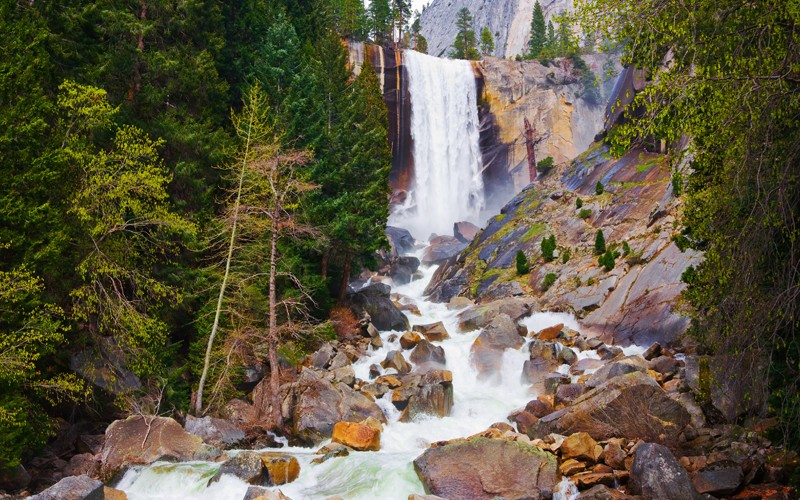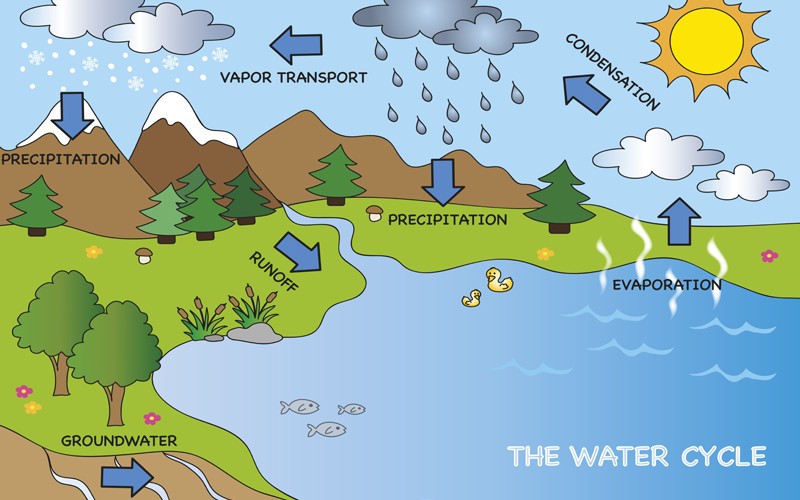Water Cycle
You are probably already aware that water covers about 97 percent of
the entire planet, right? Then maybe you’re familiar with the concept of
the water cycle, a necessary process for life on Earth. However, you
should know that the water cycle is more complicated than you think, and
there are 15 components or elements in the process.
Water is never still. We’re not just talking about currents or tides,
but also changes in their physical state: gaseous, liquid, and solid.
The hydrological process is the process in which water moves in, on, and
under the surface of the Earth, over and over again. Although it sounds
simple, it forms the basis of the existence of living beings, as they
use it for drinking and therefore, survival.
The Process of the Water Cycle.
We can’t say when and were the hydrological cycle begins because it
never stops. However, you can take the oceans as a starting point for
understanding the process.
Although usually a smaller number of steps are mentioned, there are about 15 steps or components in the water cycle:
1. Water stored in the oceans.
Most of the world’s water is in the oceans and a small percentage in
glaciers and smaller bodies of water: rivers, lakes, ponds, etc. Oceans
are therefore a kind of warehouse for a large quantity of the vital
liquid and supply nearly 90% of the evaporate water that is part of the
water cycle.
2. Evaporation.
It is a process that converts liquid water into gas or vapor, mainly
due to solar radiation. This energy from the sun is essential for water
to evaporate, which happens when it reaches 100°C, its boiling point.
At this stage, evaporated water joins with the transpiration of
plants, so together the process is often referred to as
evapotranspiration. Oceans, seas, rivers, and lakes provide nearly 90%
of the moisture that evaporates, while plants provide the other 10%. In
concrete terms, this state is characterized by the transformation of
water into steam in the air.
The hydrological process is the process in which water moves in, on, and under the surface of the Earth, over and over again.
3. Water in the atmosphere.
At this point, the water in vapor form is contained in the
atmosphere. The amount of water is still small. Imagine, if all the
water in this layer of gas fell to Earth as rain, it would cover the
ground with only 2.5 centimeters of water.
4. Condensation.
Water vapor in the atmosphere becomes drops of liquid water. This
process creates clouds and fog, and it is the opposite of evaporation.
How does this happen? Well, the water molecules combine with dust, salt, and smoke and form tiny drops that grow and join to develop clouds; this only occurs at high altitude where there is cooler air which allows this process.
How does this happen? Well, the water molecules combine with dust, salt, and smoke and form tiny drops that grow and join to develop clouds; this only occurs at high altitude where there is cooler air which allows this process.
5. Precipitation.
The condensed water vapor falls to Earth’s surface as rain,
snow, hail, sleet, fog drip, and snow pellets but most of the water
from the clouds returns in the form of rain. All these kinds of
precipitation happen due to the collision of the particles in water
vapor clouds; it takes millions of cloud droplets to produce one
raindrop.
6. Water stored in ice and snow.
The water cycle is not exactly a progression because some processes
occur at the same time as others. Thus, the water stored in glaciers,
ice fields, and snow plays a significant role in the cycle.
7. Meltwater flows into water bodies.
Frozen water flow contributes to the change and flow of rivers,
creating movement and sometimes even natural disasters. However, it is a
vital component of the water cycle.
8. Surface runoff.
The ground absorbs a portion of the rainwater and other
precipitations. The interaction between precipitation and runoff varies
according to time and geography, and can be diverted by human means
according to need.
9. Streamflow.
The amount of water flowing in a river, stream, or creek. After rain
falls, most of the water runs downhill over land in these bodies of
water.
10. Stored freshwater.
Naturally, the water that ran into rivers, streams, and creeks remains in these natural “deposits” on the Earth’s surface.
Stored freshwater is vital for the survival of living organisms since
physiologically, they are incapable of drinking salt water. Moreover,
the amount of water in rivers and lakes is constantly changing.
11. Infiltration.
A small part of the precipitation water infiltrates the soil and rock
materials. While some water remains in the most shallow layer, the rest
infiltrates deeper and can replenish groundwater.
12. Groundwater discharge.
Some groundwater discharges into streams of surface water.
13. Springs.
Springs are common water bodies where groundwater flows to the surface.
14. Perspiration.
After discharge and storage, water can evaporate again through plants and re- enter the atmosphere.
15. Stored groundwater.
Water stored underground moves slowly. These aquifers are useful,
last a long time, and make up a deposit that is part of the water cycle.


No comments:
Post a Comment